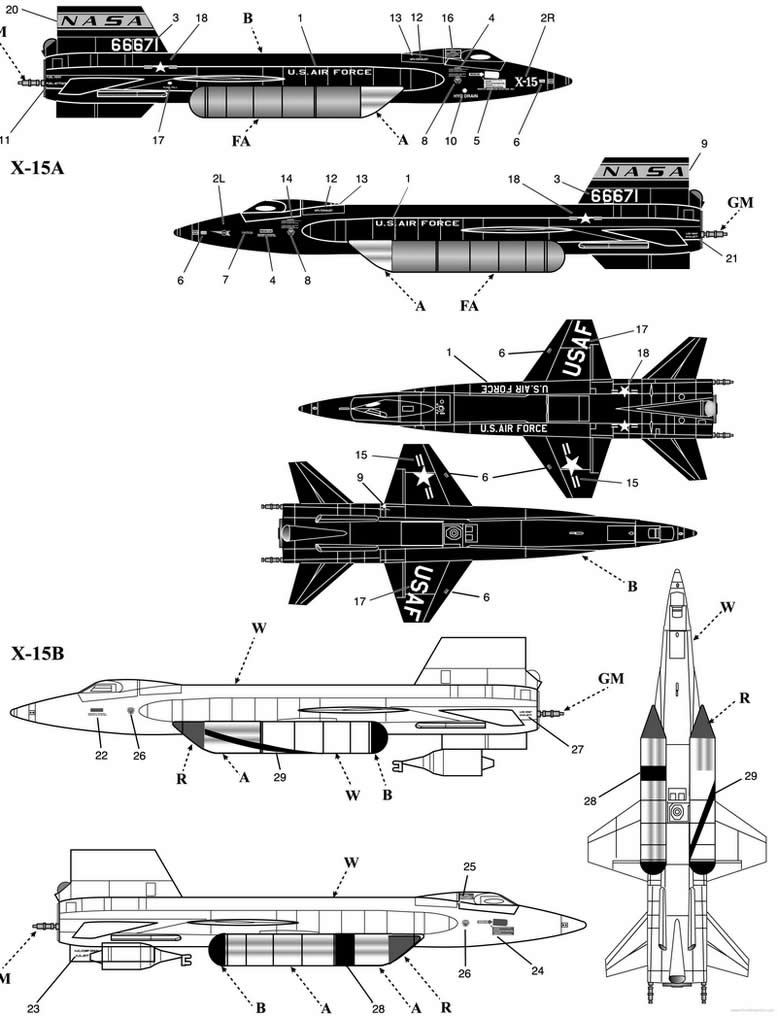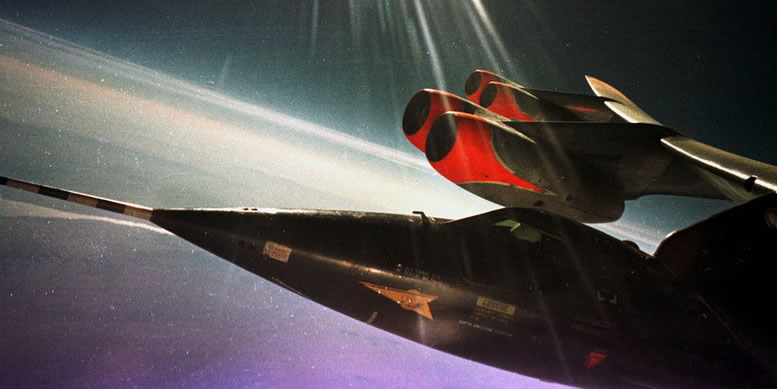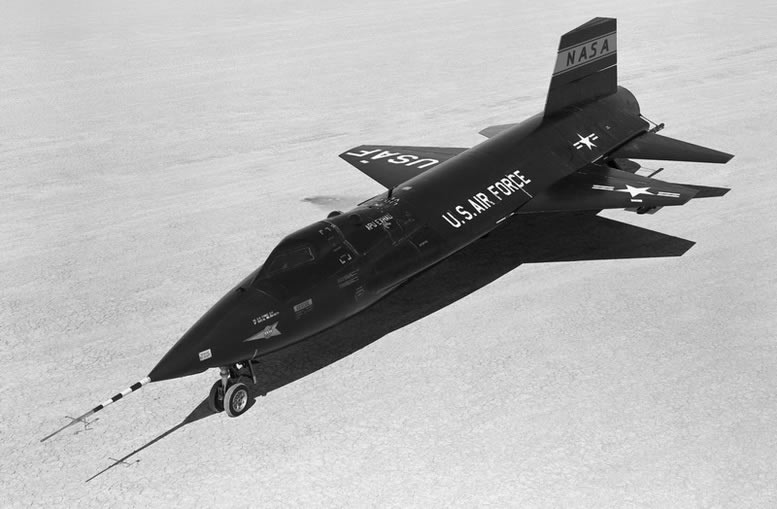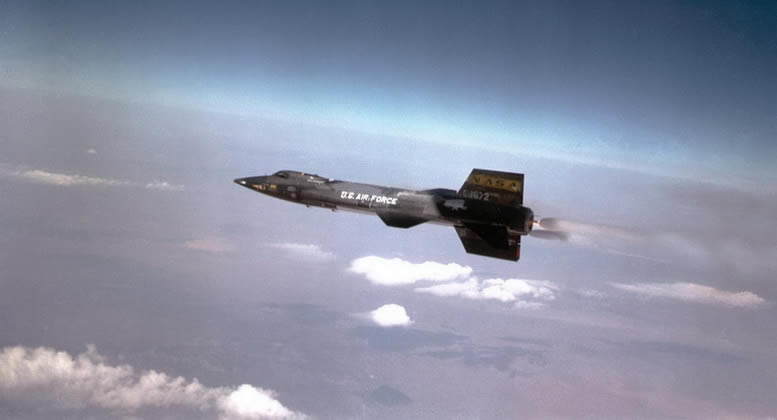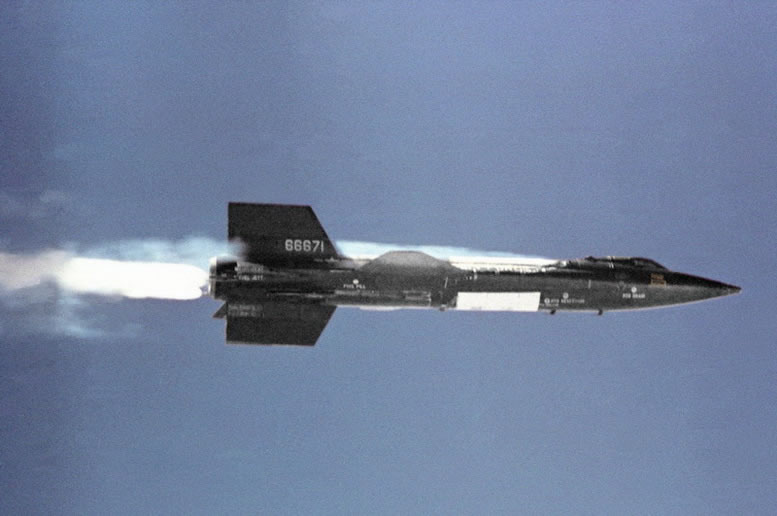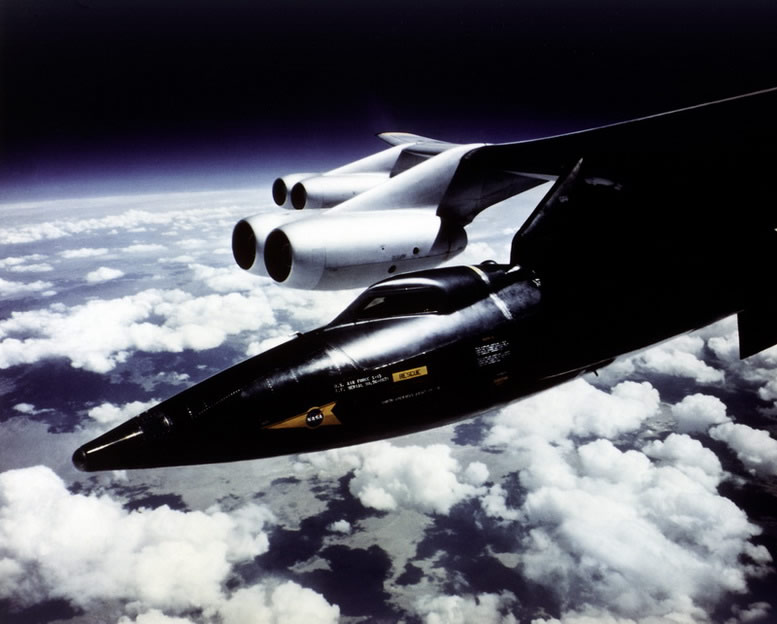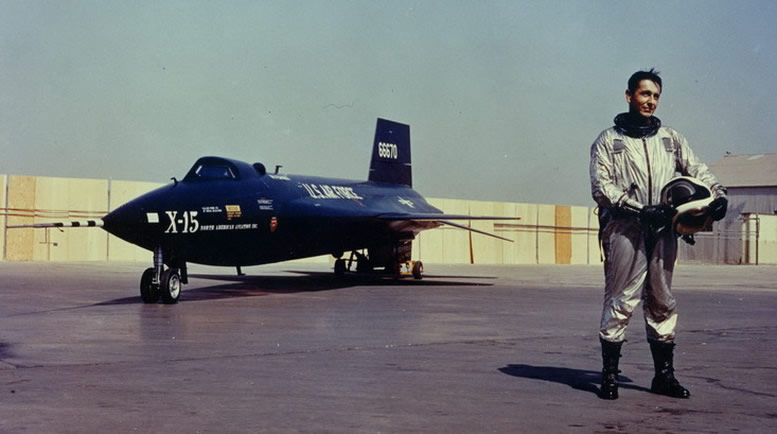NORTH AMERICAN X-15 WAS A ROCKET-POWERED AIRCRAFT OPERATED BY THE UNITED STATES AIR FORCE AND THE
NATIONAL AERONAUTICS AND SPACE ADMINISTRATION (NASA)
 North American X-15 NASA USAF Experimental Jet Aircraft |
During the X-15 program, 13 different flights by eight pilots met the USAF spaceflight criterion by exceeding the altitude of 50 miles (80 km) thus qualifying the pilots for astronaut status
The North American X-15 was a rocket-powered aircraft operated by the United States Air Force and the National Aeronautics and Space Administration (NASA) as part of the X-plane series of experimental aircraft. The X-15 set speed and altitude records in the early 1960s, reaching the edge of outer space and returning with valuable data used in aircraft and spacecraft design. As of 2012, the X-15 holds the official world record for the fastest speed ever reached by a manned aircraft.
During the X-15 program, 13 different flights by eight pilots met the USAF spaceflight criterion by exceeding the altitude of 50 miles (80 km) thus qualifying the pilots for astronaut status. The USAF pilots qualified for USAF astronaut wings, while the civilian pilots were awarded NASA astronaut wings in 2005, 35 years after the last X-15 flight.
Of all the X-15 missions, two flights (by the same pilot) qualified as space flights per the international (Fédération Aéronautique Internationale) definition of a spaceflight by exceeding 100 kilometers (62.1 mi, 328,084 ft) in altitude.
The X-15 was based on a concept study from Walter Dornberger for the NACA for a hypersonic research aircraft. The requests for proposal were published on 30 December 1954 for the airframe and on 4 February 1955 for the rocket engine. The X-15 was built by two manufacturers: North American Aviation was contracted for the airframe in November 1955, and Reaction Motors was contracted for building the engines in 1956.
Like many X- series aircraft, the X-15 was designed to be carried aloft, under the wing of a NASA B-52 mother ship, the Balls 8. Release took place at an altitude of about 8.5 miles (13.7 km) and a speed of about 805 kilometers per hour (500 mph). The X-15 fuselage was long and cylindrical, with rear fairings that flattened its appearance, and thick, dorsal and ventral wedge-fin stabilizers. Parts of the fuselage were heat-resistant nickel alloy (Inconel-X 750). The retractable landing gear comprised a nose-wheel carriage and two rear skis. The skis did not extend beyond the ventral fin, which required the pilot to jettison the lower fin (fitted with a parachute) just before landing.
The X-15 was a research aircraft, and there were changes to it over the course of the program and between the different airframes. The X-15 had to be operated under several different situations including the time attached to a carrier aircraft, drop, main engine start and acceleration, a ballistic flight into thin air/space, re-entry into thicker air, and an unpowered glide to landing. Alternatively, if the main engine was not started the pilot needed to go directly to a landing. The main rocket engine only operated for a relatively short part of the flight, but was capable of boosting the X-15 to its high-speeds and altitudes. Without the main engine on, the X-15's instruments and control surfaces remained functional, but the plane could not maintain altitude.
Because the X-15 also had to be controlled in a region where there was too little air for aerodynamic surfaces, it had a reaction control system (RCS) that used rocket thrusters. There were two different X-15 pilot controls setups: one type basically used three joysticks, and another type used one joystick.
The X-15 type with multiple control sticks for the pilot, included a traditional rudder and stick, and another joystick on the left which gave commands to the reaction control system. A third joystick on the right side was used during high G maneuvers to augment the center stick. In addition to pilot input the X-15 "Stability Augmentation System" (SAS) gave extra inputs to the aerodynamic controls to help the pilot maintain control. The reaction control system could be operated in two modes: manual and automatic. The automatic mode used a feature called "Reaction Augmentation System" (RAS) that helped stabilize the vehicle during high altitudes. The RAS was typically used for around three minutes of a X-15 flight before being automatically turned off.
The other setup used the MH-96 flight control system which allowed one joystick in place of three and simplified pilot inputs. The MH-96 could automatically blend aerodynamic and rocket controls depending on how effective each system was at controlling the X-15.
Among the many other controls, were the rocket engine throttle and a control for ejecting the bottom tail fin. Another feature of the cockpit were heated windows to prevent icing, and a forward headrest for periods of high de-acceleration. The X-15 had an ejection seat that allowed ejection at speeds up to Mach 4 and/or 120,000 feet (~36.6 km) altitude, although it was not used during the program. In the event of ejection, the seat had deployable fins which were used until it reached a safer speed/altitude, where it could deploy its main parachute. Pilots wore a pressure suit, which could be pressurized with nitrogen gas. Above 35,000 ft (~10.7 km) altitude, the cockpit was pressurized to 3.5 psi (0.24 atm) with nitrogen gas, and oxygen for breathing was fed separately to the pilot.
Early flights used two Reaction Motors XLR11 engines. Later flights were undertaken with a single Reaction Motors Inc XLR99 rocket engine generating 57,000 pounds-force (250 kN) of thrust that powered the aircraft. This engine used ammonia and liquid oxygen for propellant and hydrogen peroxide to drive the high-speed turbopump that delivered fuel to the engine. It could burn 15,000 pounds (6804 kg) of fuel in 80 seconds. The XLR99s could be throttled, and were the first such controllable engines that were man-rated.[disputed – discuss] The XLR11 used ethyl alcohol and liquid oxygen, and the XLR99 used ammonia and liquid oxygen as fuel. The X-15 reaction control system (RCS), for maneuvering in low-pressure/density environment, used hydrogen peroxide as a monopropellant. More specifically, it was high-test peroxide, which decomposes into water and oxygen in the presence of a catalyst, and can give an ISP of 140 seconds. The HTP also fueled a turbopump for the main engines and auxiliary power units (APUs). Additional tanks for helium and liquid nitrogen performed other functions, for example the fuselage interior was purged with helium gas and the liquid nitrogen was used as coolant for various systems. Altitudes attained by X-15 aircraft do not match those of Alan Shepard's and Virgil Grissom's Project Mercury space capsules in 1961, nor of any other manned spacecraft. However, the X-15 ranks supreme among manned rocket-powered aircraft, becoming the world's first operational spaceplane in the early 1960s.
Before 1958, USAF and NACA officials discussed an orbital X-15 spaceplane, the X-15B that would launch into outer space from atop an SM-64 Navajo missile. This was canceled when the NACA later became NASA and NASA adopted Project Mercury instead. By 1959, the Boeing X-20 Dyna-Soar space-glider program became the USAF's preferred means for launching military manned spacecraft into orbit; however, this program was canceled in the early 1960s before an operational vehicle could be built. Various configurations of the Navajo were considered, and another proposal proposed a Titan I stage. Three X-15s were built, flying 199 test flights, the last on 24 October 1968. The first X-15 flight was an unpowered test flight by Scott Crossfield, on 8 June 1959. Crossfield also piloted the first powered flight, on 17 September 1959, and his first flight with the XLR-99 rocket engine on 15 November 1960. Twelve test pilots flew the X-15. Among these were Neil Armstrong, later a NASA astronaut, and Joseph H. Engle, later a commander of NASA Space Shuttle test flights. In a 1962 proposal, NASA considered using the B-52/X-15 as a launch platform for a Blue Scout rocket to place satellites up to 150 pounds into orbit. In July and August 1963, pilot Joseph A. Walker exceeded 100 km in altitude, joining NASA astronauts and Soviet cosmonauts as the first human beings to cross that line on their way to outer space. The USAF awarded astronaut wings to anyone achieving an altitude of 50 mi (80.5 km), while the FAI set the limit of space at 100 kilometers (62.1 mi). On 15 November 1967, U.S. Air Force test pilot Major Michael J. Adams was killed during X-15 Flight 191 when the (X-15-3) entered a hypersonic spin while descending, then oscillated violently as aerodynamic forces increased after re-entry. As his aircraft's flight control system operated the control surfaces to their limits, acceleration built to 15 g vertical and 8.0 g lateral. The airframe broke apart at 60,000 ft (18,000 m) altitude, scattering the X-15's wreckage for 50 square miles (130 km2). On 8 June 2004, a monument was erected at the cockpit's locale, near Randsburg, California. Major Adams was posthumously awarded Air Force astronaut wings for his final flight in X-15-3, which had reached an altitude of 81.1 km (50.4 mi, 266,000 ft). In 1991, his name was added to the Astronaut Memorial. The second X-15A was rebuilt after a landing accident. It was lengthened 2.4 feet (0.73 m), a pair of auxiliary fuel tanks attached underneath its fuselage and wings, and a complete heat-resistant ablative coating was added. Renamed the X-15A-2, this plane first flew on 28 June 1964, reaching a maximum speed of 7,274 km/hr (4,520 m.p.h., 2,021 m/sec). in October 1967, flown by William "Pete" Knight of the U.S. Air Force. Five aircraft were used during the X-15 program: three X-15s planes and two B-52 Stratofortress bombers: X-15A-1 – 56-6670, 82 powered flights |
© AviationExplorer.com - The Website For Aviation Enthusiasts |





